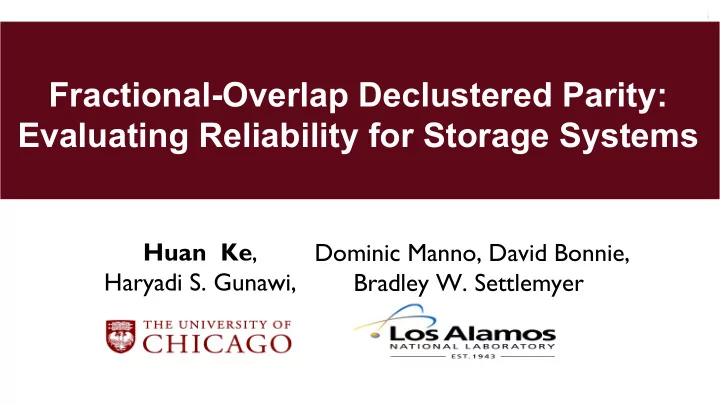

1 1 Fractional-Overlap Declustered Parity: Evaluating Reliability for Storage Systems Huan Ke , Dominic Manno, David Bonnie, Haryadi S. Gunawi, Bradley W. Settlemyer
2 Correlated Failures Correlated failures within compressed time windows make storage systems highly vulnerable to data loss. Time Disk 1 Disk 2 Disk 3 Failure Disk N System For short time periods, Real Failure Rate >> MTBF
3 Failure Models How do we model correlated failures ... Types Models Poisson Failures Exponential Failures Batch Failures
4 Traditional RAID RAID (Redundant Array of Inexpensive Disks) RAID 6 Spare disk Disk 1 Disk 2 Disk 3 Disk 4 D 1 D 2 D 3 D 4 D 5 D 6 D 7 D 8 D 9 D 10 D 11 D 12 D 13 D 14 D 15 D 16
5 Declustered Parity (DP) Data/parity are declustered or spread across all disks. distributed spare space parallel reads/writes ZFS dRAID GridRAID Spare The probability of data loss is 100% disk
6 Motivations Traditional RAID Fault Tolerance Slower reconstruction ● Declustered Parity Rebuild Performance Lower fault tolerance ● How the interactions between fault tolerance and rebuild performance together impact system reliability is still unclear.
7 F ractional O verlap D eclustered P arity FODP, a flexible tool to explore the middle space between fault tolerance and rebuild performance. D 1 D 2 D 3 D 4 D 5 D 6 D 7 D 8 D 9 D 10 D 11 D 12 D 13 D 14 D 15 D 16 Flexible rebuild performance Uniform data distribution Adjustable failure domains Higher fault tolerance
8 FODP Construction Latin square of order n: ❑ a n×n array over n elements and each element appears once in each row and column . a b c d D 1 D 6 D 11 D 16 1 2 3 4 stripe width a b c d D 2 D 5 D 12 D 15 2 1 4 3 1 D 1 D 5 D 9 D 13 D 3 D 8 D 9 D 14 3 4 1 2 2 D 2 D 6 D 10 D 14 4 3 2 1 D 4 D 7 D 10 D 13 D 3 D 7 D 11 D 15 3 D 16 D 4 D 8 D 12 4 order of n
9 Overlap fraction Each latin square corresponds to n disk subsets that cover the whole disk matrix. ❑ Each disk has (stripe-width-1) overlaps within a disk subset. Overlap fraction for each disk: RAID FODP SODP DP L M H H Rebuild Perf H H M L Fault Tolerance
10 Mutually Orthogonal Latin Squares Two latin squares are mutually orthogonal : ❑ Any order pair of entries from each latin square in the same row and column occurs exactly once. 1 2 3 4 1 3 4 2 1,1 2,3 3,4 4,2 2 1 4 3 2 4 3 1 2,2 1,4 4,3 3,1 3 4 1 2 3 1 2 4 3,3 4,1 1,2 2,4 4 3 2 1 4 2 1 3 4,4 3,2 2,1 1,3 ❑ With any given order of n, there can be at most (n-1) mutually orthogonal latin squares (MOLS).
11 MOLS in FODP a b c d 1 2 3 4 D 1 D 6 D 11 D 16 2 1 4 3 D 2 D 5 D 12 D 15 3 4 1 2 D 3 D 8 D 9 D 14 4 3 2 1 D 4 D 7 D 10 D 13 a b c d 1 D 1 D 5 D 9 D 13 1 3 4 2 D 1 D 7 D 12 D 14 2 4 3 1 D 2 D 8 D 11 D 13 2 D 2 D 6 D 10 D 14 3 1 2 4 D 3 D 5 D 10 D 16 D 3 D 7 D 11 D 15 3 4 2 1 3 D 4 D 6 D 9 D 15 D 4 D 8 D 12 D 16 4 D 1 D 8 D 10 D 15 1 4 2 3 D 2 D 7 D 9 D 16 2 3 1 4 D 3 D 6 D 12 D 13 3 2 4 1 D 4 D 5 D 11 D 14 4 1 3 2
12 Trade-offs in FODP FODP gives us the flexibility to explore the trade-offs between fault tolerance and rebuild performance. ❑ The lower is, the more failures that can be tolerated. ❑ The larger is, the more overlaps can be used for rebuilds. FODP+1 If data loss occurs, FODP loses more data than DP
13 Impact of Failures Assume MTBF = 0.5 MTTR in Campaign system with 11+2 configurations within each server.
14 Impact of Overlap Fraction
15 Impact of Overlap Fraction Failure window = 22h RebuildT < 11h
16 FODP Conclusion “Why should we address correlated failures?” Storage systems are becoming larger and denser and failures are increasingly correlated in time ! FODP , a flexible tool to study and explore rebuild performance and failure domains in systems. FODP-Plus-One , reducing the magnitude of data loss by adding a layer of parity on top of FODP stripes.
17 Thank you! Questions? http://ucare.cs.uchicago.edu
Recommend
More recommend